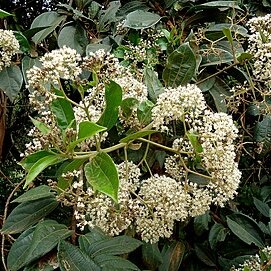Small evergreen trees, shrubs, or lianas climbing with lateral, often recurved short-shoots. Branches terete, glabrous or pubescent or with stellate-congested hairs on young branches, finally glabrate. Leaves simple, more dense towards end of branchlets; blades margin entire, apex acuminate, deep green, laxly pubescent or glabrous above, dense and whitish lanuginose or more or less glabrous below; in general 3-veined or 3-pliveined, 2-4 pairs of secondary veins, rarely more or less pinnately veined, intersecondary veins parallel reticulate, all veins below prominulous; cystoliths present. Inflorescences numerous, axillary, just under top of branch or terminal, spreading, dichasial, 8-13 times branched, terminal flower of final dichasia usually lacking; pedunculate; bracts and bracteoles in general absent, sometimes basal ramifications with leaf-like bracts; branches moderately to strongly nodose, sometimes dense and whitish or laxly pubescent. Flower buds ovoid or ellipsoid, greyish white pubescent. Flowers bisexual, or functional unisexuall; perianth lobes 4-8, in one whorl, valvate when 4-5, irregular sub-imbricate when 6-8, more or less persistent, outside greyish white pubescent, inside green to dark green, glabrous; stamens 4-5(-7), alternating with perianth lobes, filaments short, glabrous, anthers elongate, glabrous, valves opening from base to top, finally horizontally spreading, pale yellow, pollen 19-30 μm, in white heaps; staminodes and glandular appendages absent; style cylindrical, thick, with appressed hairs, stigma knob-like, small. Infructescence broad, many branched panicle, hanging, bearing few fruits, nodose, silver-white, rarely dark or brown; fruit pedicels discoid at top. Drupes silver whitish, rarely dark or brownish, often compressed, glabrous, striped, sarcocarp thin, endocarp stony, coriaceous or woody; cotyledons narrowly folded.
More
Small evergreen trees, shrubs, or lianas climbing with lateral, often recurved short-shoots. Branches terete, glabrous or pubescent or with stellate-congested hairs on young branches, finally glabrate. Leaves simple, more dense towards end of branchlets; blades margin entire, apex acuminate, deep green, laxly pubescent or glabrous above, dense and whitish lanuginose or more or less glabrous below; in general 3-veined or 3-pliveined, 2-4 pairs of secondary veins, rarely more or less pinnately veined, intersecondary veins parallel reticulate, all veins below prominulous; cystoliths present. Inflorescences numerous, axillary, just under top of branch or terminal, spreading, dichasial, 8-13 times branched, terminal flower of final dichasia usually lacking; pedunculate; bracts and bracteoles in general absent, sometimes basal ramifications with leaf-like bracts; branches moderately to strongly nodose, sometimes dense and whitish or laxly pubescent. Flower buds ovoid or ellipsoid, greyish white pubescent. Flowers bisexual, or functional unisexuall; perianth lobes 4-8, in one whorl, valvate when 4-5, irregular sub-imbricate when 6-8, more or less persistent, outside greyish white pubescent, inside green to dark green, glabrous; stamens 4-5(-7), alternating with perianth lobes, filaments short, glabrous, anthers elongate, glabrous, valves opening from base to top, finally horizontally spreading, pale yellow, pollen 19-30 μm, in white heaps; staminodes and glandular appendages absent; style cylindrical, thick, with appressed hairs, stigma knob-like, small. Infructescence broad, many branched panicle, hanging, bearing few fruits, nodose, silver-white, rarely dark or brown; fruit pedicels discoid at top. Drupes silver whitish, rarely dark or brownish, often compressed, glabrous, striped, sarcocarp thin, endocarp stony, coriaceous or woody; cotyledons narrowly folded.

